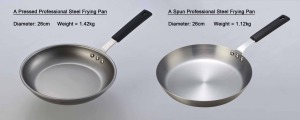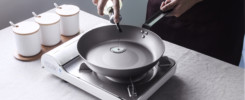All Professional Steel pans are produced from either black or grey steel. Each has advantages for cookware use. One particular benefit of black steel is its resistance to corrosion: it has a natural oxide outer layer which protects the steel from oxidation. Another advantage is that, unlike grey steel, which will discolour if heated to too high a temperature during production, black steel can be cured with cooking oil in an oven at a high temperature. Consequently, black steel pans can be conditioned and packaged as pre-seasoned, without a protective coating which has to be removed before use. Grey steel, on the other hand, is preferred by some customers because the development of the non-stick patina can be more easily monitored on the surface of the pan. Also, it can be argued that grey steel is easier to clean because burnt-on oil or other ingredients are more easily recognized than on the darker surface of black steel.
However, although black and grey steel have different surface qualities, they do have a very similar chemical composition, strength, hardness and heating effect for cooking. So if these materials are so similar, and both go through an identical iron- and steel-making process, what is it that causes them to have different surface qualities?
After steel is produced from iron via the Basic Oxygen Furnace it is cast into thick rectangular slabs. Before these can be sent to a factory to be machined and shaped into the final product they must be strip processed into steel sheets which can be coiled up and packaged for easy transportation. Strip processing involves using two large rollers to compress the slabs to improve surface finish, alter the grain structure, and most importantly, to reduce thickness.
Hot Rolling Process
When steel arrives for strip processing in the form of thick slabs it has a very coarse grain structure. In order to reduce the slabs’ thickness and improve their ductility, these grains need to be recrystallized so that new, finer grains can nucleate and develop in their place. Hot rolling the steel at elevated temperatures in a reheating furnace makes the steel very soft and easier to shape into thinner, more malleable sheets.
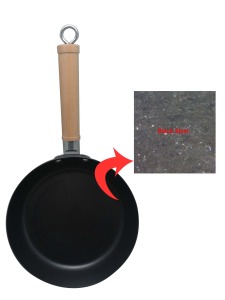 The last stage of the hot rolling process requires the surface to be de-scaled, which is to remove the 1/8 inch-thick layer of oxidized iron that forms at the surface of the slab in the oxygen-rich atmosphere of the reheating furnace. However, even after this process has been finished some of the oxidized iron remains on the surface, and it is for this reason that cookware which is manufactured from hot-rolled steel is called black steel.
The last stage of the hot rolling process requires the surface to be de-scaled, which is to remove the 1/8 inch-thick layer of oxidized iron that forms at the surface of the slab in the oxygen-rich atmosphere of the reheating furnace. However, even after this process has been finished some of the oxidized iron remains on the surface, and it is for this reason that cookware which is manufactured from hot-rolled steel is called black steel.
Pickling
Although the end product of the hot rolling process is black steel, it is also possible to produce hot-rolled grey steel. After the hot-rolled steel has been de-scaled it can be further treated with hydrochloric acid to remove the remaining black metal oxide layer from its surface. Once this treatment, commonly called Pickling, is complete the hot-rolled steel is left with a grey matte finish.
Hot Rolled Cookware
Hot-rolled steel has some disadvantages for general factory production. First, it cannot be produced to precise measurements because hot rolled steel reduces in size during cooling. Second, even after the hot rolled steel has been pickled, the surface finish is too uneven for some factory processes, including applying a protective coating.
For Professional Steel hot-rolled cookware these disadvantages are not so important. Unlike some products produced from hot-rolled steel, black and grey steel cookware does not need to be produced to such fine measurements. Moreover, the transparent glaze wax coating on all Professional Steel does not require a very even surface.
In fact, the uneven surface finish of hot-rolled steel is actually beneficial for the development of the non-stick patina on Professional Steel pans. Pans with chemical non-stick coatings, such as a PTFE or ceramic coating, are often grit blasted before the coating is sprayed on, to help it adhere to the pan. Similarly, when non-coated pans are seasoned by heating with cooking oil, the resulting polymerized fat is better able to bond to an uneven steel surface. The ‘valleys’ on the uneven surface of hot-rolled steel allow the consumer to produce a durable, high quality patina non-stick effect.
In addition, a roughened surface provides a better non-stick surface while your pan is still in the process of developing its non-stick patina. If you were to fry an egg on a flat surface, such as a stainless steel pan, a lot of the oil would not remain on the pan but would stick to the egg as it was turned over. 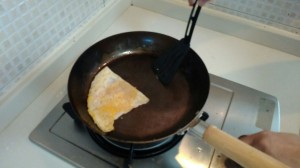 With an hot rolled steel uneven surface, on the other hand, a greater amount of oil will remain in the ‘valleys’ to provide further non-stick release for cooking the other side of the fried egg.
With an hot rolled steel uneven surface, on the other hand, a greater amount of oil will remain in the ‘valleys’ to provide further non-stick release for cooking the other side of the fried egg.
Cold Rolling
For grey steel, the surface finish is rather different because it is produced by cold rolling, which is done at room temperature. Cold rolling is done after the hot rolling and pickling processes have been completed for the following purposes: further reduction of the strip thickness; improvement of the surface finish; and improvement of the surface flatness.
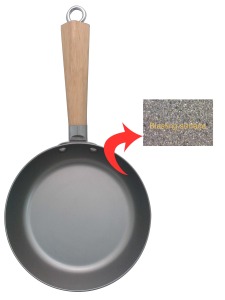 Most general grey steel cookware sold throughout the world today is manufactured and packaged with the cold-rolled flat surface finish mentioned above, sometimes with the the surface flattened even further by polishing, which gives a shinier appearance. However, as explained for hot-rolled steel, a roughened, uneven surface is actually beneficial for cooking in utensils like frying pans and stir woks. For this reason all Professional Grey Steel pans are grit blasted during the production process to produce an uneven, roughened surface, similar to that of hot-rolled steel.
Most general grey steel cookware sold throughout the world today is manufactured and packaged with the cold-rolled flat surface finish mentioned above, sometimes with the the surface flattened even further by polishing, which gives a shinier appearance. However, as explained for hot-rolled steel, a roughened, uneven surface is actually beneficial for cooking in utensils like frying pans and stir woks. For this reason all Professional Grey Steel pans are grit blasted during the production process to produce an uneven, roughened surface, similar to that of hot-rolled steel.
However, cold-rolled steel does have one advantage over hot-rolled steel, and that is its better ductility. Cold rolling is done at room temperature, which is well below the steel’s recrystallization temperature and causes the crystal grains within the steel to become compressed, making the steel actually harder, stronger and less ductile than hot-rolled steel. A further process, called Annealing, is required to make the grey steel less hard and more ductile for shape into cookware than hot-rolled steel. This involves reheating the steel to elevated temperatures, above its recrystallization temperature, then letting it ‘soak’ for a while, and after that letting the steel cool down slowly in a heated oven. During this process new grains in the steel are grown to replace the work-hardened crystal grains from the cold rolling. After annealing is complete these grains are larger and more evenly shaped within the grey steel’s structure than they were after cold rolling, and also than after hot rolling. Consequently, this heat treatment makes the steel more ductile and suitable for shaping in the factory into items such as Professional Steel cookware.
Spinning and Stamping
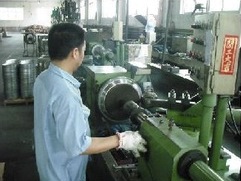 When making carbon steel cookware in the factory, there are two basic production processes used to shape the steel into pans, such as frying pans and stir woks: stamping and spinning. Compared to other production processes for cookware, such as extruding or forging, stamping and spinning are quite similar, but there is one significant difference between them: the final thickness of the pan. For cookware which is produced from stamping, the base and side of the pan will have the same thickness; from spinning the base of the pan is always thicker than the sides.
When making carbon steel cookware in the factory, there are two basic production processes used to shape the steel into pans, such as frying pans and stir woks: stamping and spinning. Compared to other production processes for cookware, such as extruding or forging, stamping and spinning are quite similar, but there is one significant difference between them: the final thickness of the pan. For cookware which is produced from stamping, the base and side of the pan will have the same thickness; from spinning the base of the pan is always thicker than the sides.
For dry-heat cooking methods, such as pan-frying, sautéing and stir frying, a high heat is most needed at the base of the pan. Conversely, for moist-heat cooking methods it is very necessary to have the sides of the pan be as thick as the base, because you want to trap heat inside the pan as much as possible. Professional Steel pans, because of their reactive surface, can only ever be used for dry-heat cooking, so a thick-sided pan is not only unnecessary, but adds extra cost, and most importantly, a lot of extra weight to the product. Compared to a metal such as aluminum, carbon steel is very dense, and when produced at a thick gauge, as in a Professional Steel pan, will have an excellent heating effect but can also be quite heavy. Therefore, the weight of a Professional Steel pan can be reduced if it is not pressed but instead spun.
Generally, for most frying pans Professional Steel is produced at a 2.0mm gauge. This thickness is a good compromise between cost and heating effect/ durability. However, Professional Steel pans can also be produced in thicker gauges, such as 2.2mm, 2.5mm or even 3.0mm. A stamped 2.5mm gauge pan would be very heavy and quite a challenge for the average consumer to move around the kitchen on a regular basis. It would make more sense to spin the pan so it has a 2.5mm thick base, but an edge somewhere closer to 2.0mm in thickness. This way the pan would have a cast iron-like heating capacity due to its thick base, while at the same time weighing and costing a lot less.
With cold-rolled/annealed grey steel it is possible to spin a pan up to a 2.5mm thickness. However, with hot-rolled steel is it not possible to spin a frying pan above a 2.0mm gauge; it would have to be pressed instead.
A hot-rolled pan or a cold-rolled Professional Steel pan?
Whether a consumer uses a hot-rolled black or grey steel pan or a cold-rolled grit-blasted grey steel pan, they will enjoy the benefits of a highly durable, chemical-free, metal utensil-safe cookware product with an excellent heating effect. However, when they make their purchase they might want to consider a few factors, such as the corrosion resistance of the pan; its appearance after use; and the weight of the pan.
If you want a pan, such as a stir wok, that can be stored in a cupboard for a few weeks between uses then you might want to consider black steel. This has an oxide outer layer which provides a buffer between the steel and the air to withstand oxidation and rust. Whether you choose hot-rolled or cold-rolled steel, all Professional Steel pans can develop polymerized fat on their surface for an excellent non-stick patina. However, if you prefer to watch the pan darken with use, then you might consider a grey steel pan. Then again, if you want a pan that is already pre-seasoned for an excellent non-stick effect immediately upon use then you should consider using a black steel pan. Lastly, there is also the option to choose a pan which has a very thick base for an excellent heating effect, for example to brown a steak with a delicious, caramelized crust, but which is not too heavy for cooking use. If so, then you might consider a cold-rolled grey steel pan, which is ductile enough to be spun at a thickness more than 2.0mm.
